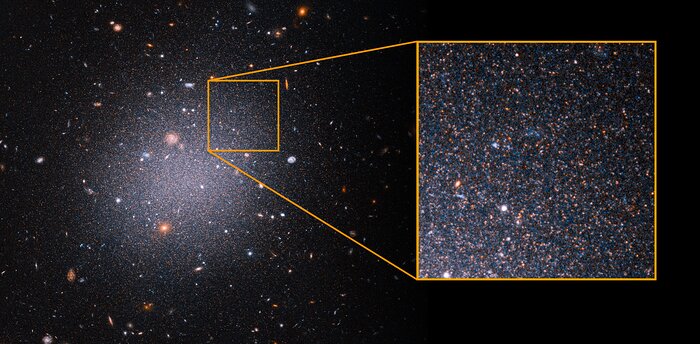NGC1052-DF2 with pull-out of red giant stars
This image from the NASA/ESA Hubble Space Telescope offers a sampling of aging, red stars in the ultra-diffuse galaxy NGC 1052-DF2, or DF2. The galaxy continues to puzzle astronomers because it is lacking dark matter, an invisible form of matter that provides the gravitational glue to hold galaxies together. Precisely establishing the galaxy’s distance from Earth is a step toward solving the mystery.
The close-up at right reveals the many aging red giant stars on the outskirts of the galaxy that are used as intergalactic milepost markers. Researchers calculated a more accurate distance to DF2 by using Hubble to observe about 5,400 red giants. These older stars all reach the same peak brightness, so they are reliable yardsticks to measure distances to galaxies.
The research team estimates that DF2 is 72 million light-years from Earth. They say the distance measurement solidifies their claim that DF2 lacks dark matter. The galaxy contains at most 1/400th the amount of dark matter that the astronomers had expected, based on theory and observations of many other galaxies.
Called an ultra-diffuse galaxy, the galactic oddball is almost as wide as the Milky Way, but it contains only 1/200th the number of stars as our galaxy. The ghostly galaxy doesn't appear to have a noticeable central region, spiral arms, or a disk.
The observations were taken between December 2020 and March 2021 with Hubble's Advanced Camera for Surveys.
Credit:NASA, ESA, STScI, Zili Shen (Yale), Pieter van Dokkum (Yale), Shany Danieli (IAS), Alyssa Pagan (STScI)
Colours & filters
| Band | Wavelength | Telescope |
|---|---|---|
| Optical V | 606 nm |
Hubble Space Telescope
WFC3 |
| Optical V | 606 nm |
Hubble Space Telescope
WFC3 |
| Optical I | 814 nm |
Hubble Space Telescope
WFC3 |
| Optical I | 814 nm |
Hubble Space Telescope
WFC3 |
